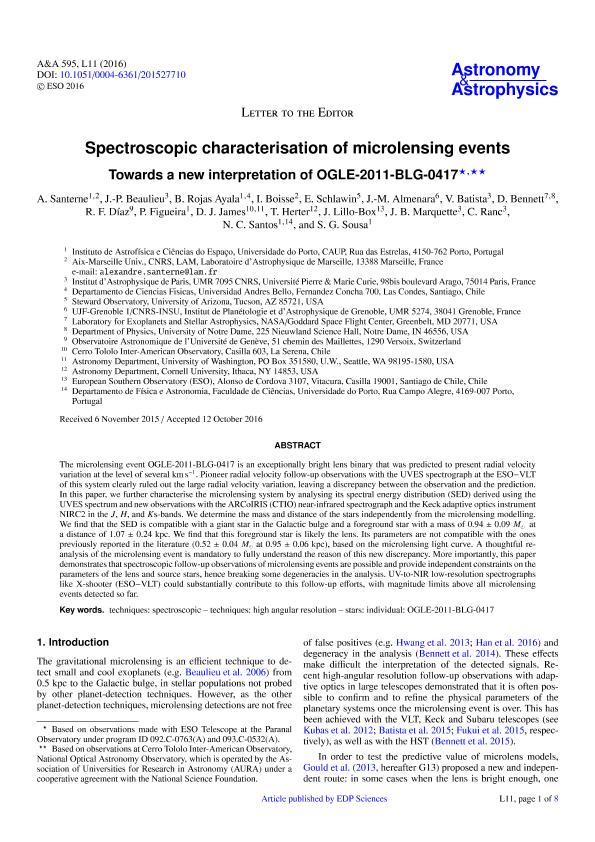Mostrar el registro sencillo del ítem
dc.contributor.author
Santerne, A.
dc.contributor.author
Beaulieu, J. P.
dc.contributor.author
Rojas Ayala, B.
dc.contributor.author
Boisse, I.
dc.contributor.author
Schlawin, E.
dc.contributor.author
Almenara, J.-M.
dc.contributor.author
Batista, V.
dc.contributor.author
Bennett, D.
dc.contributor.author
Diaz, Rodrigo Fernando

dc.contributor.author
Figueira, P.
dc.contributor.author
James, D. J.
dc.contributor.author
Herter, T.
dc.contributor.author
Lillo Box, J.
dc.contributor.author
Marquette, J. B.
dc.contributor.author
Ranc, C.
dc.contributor.author
Santos, N. C.
dc.contributor.author
Sousa, S. G.
dc.date.available
2017-06-19T18:13:10Z
dc.date.issued
2016-11
dc.identifier.citation
Santerne, A.; Beaulieu, J. P.; Rojas Ayala, B.; Boisse, I.; Schlawin, E.; et al.; Spectroscopic characterisation of microlensing events: Towards a new interpretation of OGLE-2011-BLG-0417; Edp Sciences; Astronomy And Astrophysics; 595; L11; 11-2016; 1-8
dc.identifier.issn
0004-6361
dc.identifier.uri
http://hdl.handle.net/11336/18441
dc.description.abstract
The microlensing event OGLE-2011-BLG-0417 is an exceptionally bright lens binary that was predicted to present radial velocity variation at the level of several km s-1. Pioneer radial velocity follow-up observations with the UVES spectrograph at the ESO−VLT of this system clearly ruled out the large radial velocity variation, leaving a discrepancy between the observation and the prediction. In this paper, we further characterise the microlensing system by analysing its spectral energy distribution (SED) derived using the UVES spectrum and new observations with the ARCoIRIS (CTIO) near-infrared spectrograph and the Keck adaptive optics instrument NIRC2 in the J, H, and Ks-bands. We determine the mass and distance of the stars independently from the microlensing modelling. We find that the SED is compatible with a giant star in the Galactic bulge and a foreground star with a mass of 0.94 ± 0.09 M⊙ at a distance of 1.07 ± 0.24 kpc. We find that this foreground star is likely the lens. Its parameters are not compatible with the ones previously reported in the literature (0.52 ± 0.04 M⊙ at 0.95 ± 0.06 kpc), based on the microlensing light curve. A thoughtful re-analysis of the microlensing event is mandatory to fully understand the reason of this new discrepancy. More importantly, this paper demonstrates that spectroscopic follow-up observations of microlensing events are possible and provide independent constraints on the parameters of the lens and source stars, hence breaking some degeneracies in the analysis. UV-to-NIR low-resolution spectrographs like X-shooter (ESO−VLT) could substantially contribute to this follow-up efforts, with magnitude limits above all microlensing events detected so far.
dc.format
application/pdf
dc.language.iso
eng
dc.publisher
Edp Sciences

dc.rights
info:eu-repo/semantics/openAccess
dc.rights.uri
https://creativecommons.org/licenses/by-nc-sa/2.5/ar/
dc.subject
Techniques: Spectroscopic
dc.subject
Techniques: High Angular Resolution
dc.subject
Stars: Individual: Ogle-2011-Blg-0417
dc.subject.classification
Astronomía

dc.subject.classification
Ciencias Físicas

dc.subject.classification
CIENCIAS NATURALES Y EXACTAS

dc.title
Spectroscopic characterisation of microlensing events: Towards a new interpretation of OGLE-2011-BLG-0417
dc.type
info:eu-repo/semantics/article
dc.type
info:ar-repo/semantics/artículo
dc.type
info:eu-repo/semantics/publishedVersion
dc.date.updated
2017-06-13T14:14:52Z
dc.journal.volume
595
dc.journal.number
L11
dc.journal.pagination
1-8
dc.journal.pais
Francia

dc.journal.ciudad
Paris
dc.description.fil
Fil: Santerne, A.. Universidade do Porto; Portugal
dc.description.fil
Fil: Beaulieu, J. P.. Université Pierre & Marie Curie; Francia
dc.description.fil
Fil: Rojas Ayala, B.. Universidad Andres Bello; Chile
dc.description.fil
Fil: Boisse, I.. Laboratoire d’Astrophysique de Marseille; Francia
dc.description.fil
Fil: Schlawin, E.. University Of Arizona; Estados Unidos
dc.description.fil
Fil: Almenara, J.-M.. Institut de Planétologie et d’Astrophysique de Grenoble; Francia
dc.description.fil
Fil: Batista, V.. Université Pierre & Marie Curie; Francia
dc.description.fil
Fil: Bennett, D.. National Aeronautics And Space Administration. Goddart Institute For Space Studies; Estados Unidos
dc.description.fil
Fil: Diaz, Rodrigo Fernando. Consejo Nacional de Investigaciónes Científicas y Técnicas. Oficina de Coordinación Administrativa Ciudad Universitaria. Instituto de Astronomía y Física del Espacio. - Universidad de Buenos Aires. Facultad de Ciencias Exactas y Naturales. Instituto de Astronomía y Física del Espacio; Argentina
dc.description.fil
Fil: Figueira, P.. Universidade do Porto; Portugal
dc.description.fil
Fil: James, D. J.. Cerro Tololo Inter-American Observatory; Chile
dc.description.fil
Fil: Herter, T.. Cornell University; Estados Unidos
dc.description.fil
Fil: Lillo Box, J.. European Southern Observatory; Chile
dc.description.fil
Fil: Marquette, J. B.. Université Pierre & Marie Curie; Francia
dc.description.fil
Fil: Ranc, C.. Université Pierre & Marie Curi; Francia
dc.description.fil
Fil: Santos, N. C.. Universidade do Porto; Portugal
dc.description.fil
Fil: Sousa, S. G.. Universidade do Porto; Portugal
dc.journal.title
Astronomy And Astrophysics

dc.relation.alternativeid
info:eu-repo/semantics/altIdentifier/doi/http://dx.doi.org/10.1051/0004-6361/201527710
dc.relation.alternativeid
info:eu-repo/semantics/altIdentifier/url/https://arxiv.org/abs/1610.04446
dc.relation.alternativeid
info:eu-repo/semantics/altIdentifier/url/https://www.aanda.org/articles/aa/abs/2016/11/aa27710-15/aa27710-15.html
Archivos asociados
